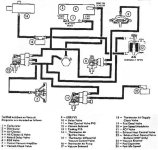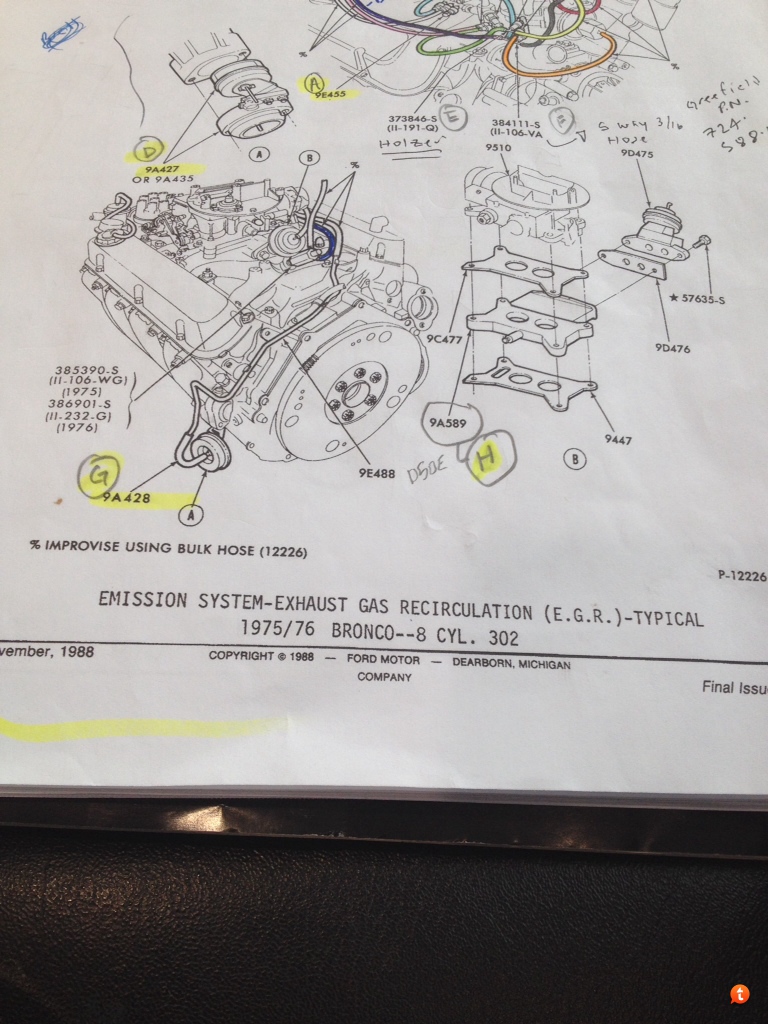JT
Full Member
- Joined
- Sep 14, 2012
- Messages
- 159
Ok guys...I'm so very close to having this figured out but need a little help to get me across the goal line.
I've been researching vacuum line routing for my 1975. My intent is to take it back to stock (provided I can get the right air pump, diverter valve, etc.).
In my master parts catalog (illustration section) I have the diagram in pic 1. I've been piecing together the components but couldn't for the life of me figure out what the green highlighted part was (the part with the red and black vacuum lines going into it)...that is until I came across the diagram in pic 2. In pic 2, the part marked "12" is the vacuum solenoid.
I'm pretty sure that the red line in pic 1 is the same as the line in pic 2 going from item 12 to item 15. The black line in pic 1 appears to be the same as the line in pic 2 going from the vacuum tree in branching to the PVS item 13 and also to the vacuum solenoid item 12.
There are, however, two problems:
1) I searched my master parts catalog (part list section) I can't find the part # for the vacuum solenoid.
2) Even if I had the vacuum solenoid, it appears that it is a powered part and I have no idea how to get power to it or what connector to use.
By the way, Pic 3 is from my shop manual and confirms the general vacuum line routing for the EGR and distributor (albeit simpler than pic 1 and pic 2 do).
Any help you guys can give on the vacuum solenoid and how to power it would be a big help.
As always...thanks.
JT
Pic 1

Pic 2

Pic 3

I've been researching vacuum line routing for my 1975. My intent is to take it back to stock (provided I can get the right air pump, diverter valve, etc.).
In my master parts catalog (illustration section) I have the diagram in pic 1. I've been piecing together the components but couldn't for the life of me figure out what the green highlighted part was (the part with the red and black vacuum lines going into it)...that is until I came across the diagram in pic 2. In pic 2, the part marked "12" is the vacuum solenoid.
I'm pretty sure that the red line in pic 1 is the same as the line in pic 2 going from item 12 to item 15. The black line in pic 1 appears to be the same as the line in pic 2 going from the vacuum tree in branching to the PVS item 13 and also to the vacuum solenoid item 12.
There are, however, two problems:
1) I searched my master parts catalog (part list section) I can't find the part # for the vacuum solenoid.
2) Even if I had the vacuum solenoid, it appears that it is a powered part and I have no idea how to get power to it or what connector to use.
By the way, Pic 3 is from my shop manual and confirms the general vacuum line routing for the EGR and distributor (albeit simpler than pic 1 and pic 2 do).
Any help you guys can give on the vacuum solenoid and how to power it would be a big help.
As always...thanks.
JT
Pic 1

Pic 2

Pic 3

Last edited:


















